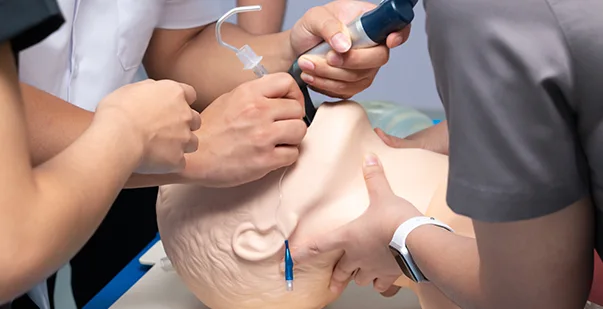Table Of Content(s)
- Introduction
- Understanding Airway Obstruction: What Happens
- Difference Between Mild and Severe Airway Obstruction
- Elaborate on the signs of severe airway obstruction BLS
- What are the steps of Basic Life Support for Severe Airway Obstruction
- How to perform the Heimlich Maneuver: Step by Step
- Preventing Airway Obstruction: Tips for Safety
- What does a Basic Life Support Training Course Cover?
- Conclusion
Imagine this, a person right in front of you struggles to breathe and collapses all of a sudden. His face turns pale and panic spreads across the room. Would you be capable of handling the situation with expertise?
Choking due to severe airway obstruction happens to be the fourth leading cause of unintentional injury death. Educating yourself on the signs of severe airway obstruction can help save thousands of lives everyday.
Knowing what to look for is important. The common signs include difficulty breathing, wheezing, or a complete inability to speak or cough. But how can you quickly tell if someone is experiencing a severe airway obstruction?
In this blog we will find out in depth the signs of severe airway obstruction as per the guidelines of Basic Life Support (BLS).
Master BLS Now
Get BLS certified with confidence
Understanding Airway Obstruction: What Happens
Airway obstruction occurs when the airway is partially or completely blocked. This prevents oxygen from reaching the lungs. The blockage can be life-threatening, and recognizing it quickly is critical for effective intervention.
Read More: Online BLS certification course
Difference Between Mild and Severe Airway Obstruction
The difference between mild and severe airway obstruction depends on the level of blockage. It also determines the urgency of the response required. Below are the core differences:
| Factors | Mild Airway Obstruction | Severe Airway Obstruction |
| Airflow | Some airflow is present | There’s no airflow at all |
| Signs | Coughing, wheezing, and difficulty speaking. | Inability to cough, speak, or breathe; possible silent choking and cyanosis (bluish skin). |
| Response | Encourage the person to continue coughing to clear the airway on their own. | Immediate intervention is required, such as the Heimlich maneuver or CPR if the person becomes unresponsive. |
Read More: Basic Airway Management in Children
Elaborate on the Signs of Severe Airway Obstruction BLS
Recognizing the signs of severe airway obstruction in BLS is critical. Swift action can save a life. Here are the key indicators that the airway is fully blocked and requires immediate intervention.
- Inability to Speak or Cough: The person may try to cough but is unable to clear the obstruction or make any sound.
- Gasping or Struggling to Breathe: Visible distress with attempts to breathe, but no air is moving in or out.
- Silent Choking: No sounds come from the airway, even though the person is clearly choking.
- Cyanosis: The skin, especially around the lips and face, may turn blue due to a lack of oxygen.
- Clutching the Throat: Often referred to as the universal choking sign, the person may instinctively grab their throat.
- Loss of Consciousness: If the obstruction is not cleared, the person may become unresponsive due to lack of oxygen.
What are the steps of Basic Life Support for Severe Airway Obstruction
Basic Life Support (BLS) offers clear steps to effectively manage a blocked airway and restore normal breathing. These steps will help you understand the path to a successful BLS intervention:
- Assess the Situation: Check for signs of severe obstruction, such as inability to cough or speak, and the universal choking sign.
- Encourage Coughing: If the person is still able to breathe or cough, encourage them to do so forcefully.
- Perform Abdominal Thrusts (Heimlich Maneuver): If coughing is ineffective and the person cannot breathe, perform abdominal thrusts to dislodge the object.
- For Unresponsive Victims: If the person becomes unresponsive, gently lower them to the ground and call for emergency help.
- Begin CPR: Start chest compressions and rescue breaths if the person is unresponsive, checking the airway after each set to see if the obstruction has been cleared.
- Check the Airway: If you can see the object causing the obstruction, carefully attempt to remove it; do not perform blind finger sweeps.
- Continue Until Help Arrives: Keep providing CPR or abdominal thrusts until emergency personnel take over or the person recovers.
Read More: Basic airway management in adults
How to perform the Heimlich Maneuver: Step by Step
The Heimlich maneuver is a life-saving technique used to relieve severe airway obstruction. Here’s how to perform it step-by-step:
- Position Yourself: Stand behind the person and wrap your arms around their waist.
- Make a Fist: Place your fist just above the person’s navel, thumb-side in.
- Grasp Your Fist: With your other hand, grasp the fist tightly.
- Perform Abdominal Thrusts: Pull inward and upward sharply to create pressure and force the object out.
- Repeat: Continue abdominal thrusts until the object is expelled or the person becomes unresponsive.
- For Unresponsive Victims: If the person loses consciousness, gently lower them and begin CPR while checking the airway between compressions.
Preventing Airway Obstruction: Tips for Safety
Preventing airway obstruction is key to avoiding life-threatening emergencies. Simple precautions can reduce the risk of choking and other airway blockages.
- Chew Food Thoroughly: Always chew food well before swallowing, especially for children and elderly individuals.
- Avoid Talking While Eating: Speaking and eating simultaneously increases the risk of choking.
- Supervise Small Children: Keep small objects, toys, and hard foods like nuts or candies out of reach of young children.
- Cut Food Into Small Pieces: Ensure food is cut into manageable, bite-sized portions to prevent choking, especially for toddlers and seniors.
- Limit Alcohol Consumption: Drinking too much alcohol can impair swallowing reflexes, increasing the risk of choking.
- Be Cautious with Dentures: Denture wearers should be careful when chewing, as food can become lodged more easily.
- Educate on Heimlich Maneuver: Ensure family members and caregivers know how to perform the Heimlich maneuver in case of emergency.
What does a Basic Life Support Training Course Cover?
A Basic Life Support course covers crucial techniques for managing respiratory and cardiac emergencies.
- CPR Techniques: Instruction on performing high-quality chest compressions and rescue breaths for adults, children, and infants.
- Use of an AED: Training on how to use an Automated External Defibrillator (AED) to treat sudden cardiac arrest.
- Choking Relief: Techniques for recognizing and responding to choking, including the Heimlich maneuver.
- Recognition of Cardiac Arrest: Identifying the signs and symptoms of cardiac arrest and understanding when to call for help.
- Team Dynamics: Effective communication and teamwork during resuscitation efforts.
- First Aid Basics: Overview of basic first aid principles relevant to life-threatening situations.
Conclusion
Recognizing the signs of severe airway obstruction is important for effective interventions. Awareness of symptoms such as inability to speak, silent choking, and cyanosis can prepare you to act quickly and decisively. Whether you are a professional or a layperson, understanding these signs will help you gain the knowledge to save someone’s life in need. Master the BLS technique through a Basic Life Support course and restore someone’s ability to breathe and ensure their survival.







